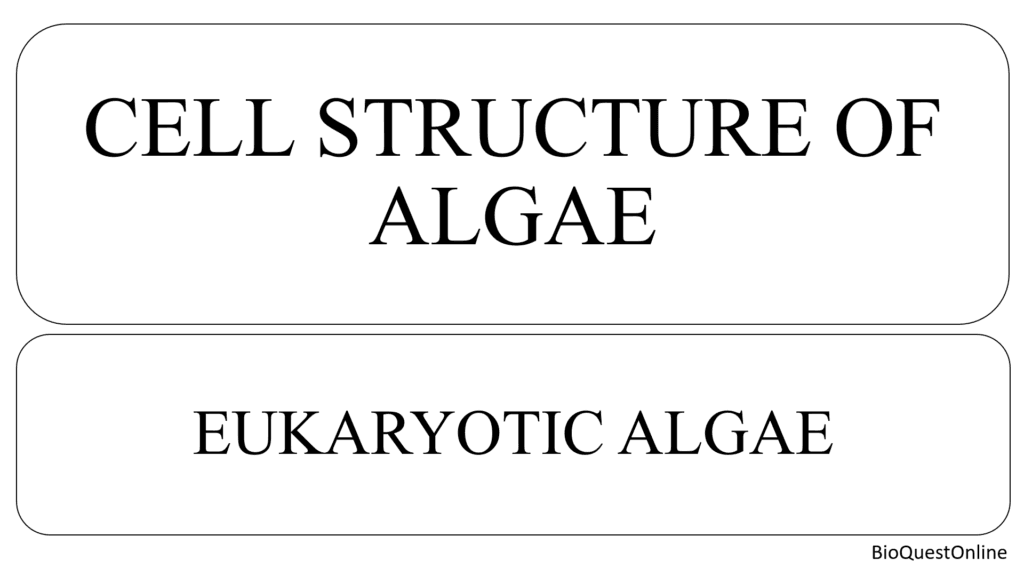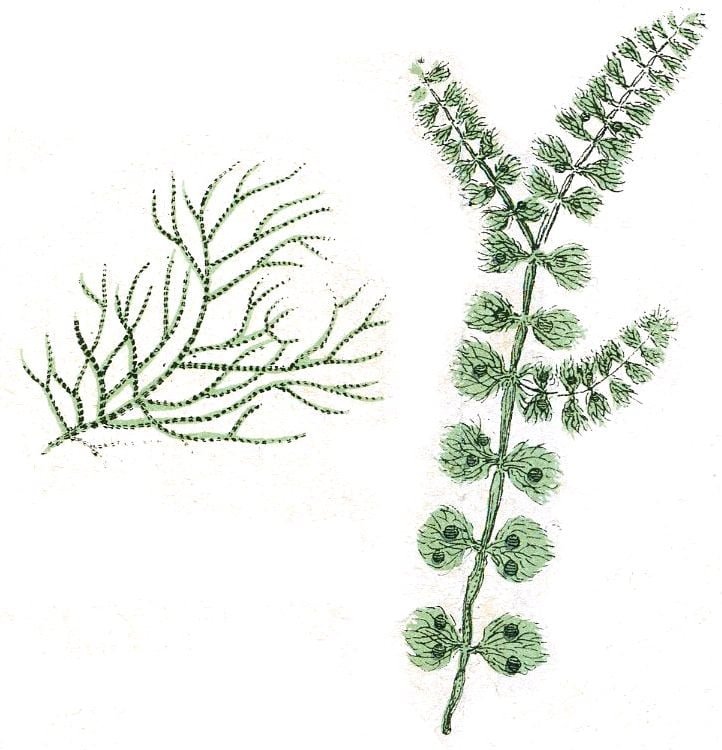Cell structure of eukaryotic algae consist of cell wall, plasma membrane, plastids, pyrenoids, nucleus, mitochondria, golgi body, endoplasmic reticulum, vacuole, flagella, eye spots etc.
Whereas, cell structure of algae in prokaryotic form reveals the presence of a incipient nucleus which lacks a nuclear membrane, and the DNA is dispersed within the nucleoplasm.
Hence, based on cell structure, algae can be categorized into two groups: Prokaryotic algae and Eukaryotic algae.
Cell Structure of Eukaryotic Algae
Eukaryotic algae are classified into several divisions, each characterized by distinct cell structures and unique traits.
Common features across all groups of eukaryotic algae include a membrane-bound nucleus, chromosomes, plastids, mitochondria, Golgi bodies, and 80S type of ribosomes.
In addition, cell division occurs through mitosis, many groups of eukaryotic algae also reproduce sexually, involving gamete fusion and meiosis (reduction division).

Cell structure of eukaryotic algae comprises the cell wall, plasma membrane, plastids, pyrenoids, nucleus, mitochondria, Golgi bodies, endoplasmic reticulum, vacuoles, flagella, and eyespots.
Cell Wall
- The cell wall of eukaryotic algae is primarily composed of cellulose, with additional compounds added during development.
- In brown algae, substances such as hemicelluloses, alginic acid, fucan, and fucoidin are also present.
- In diatoms, the cell wall is primarily made of silica.
- The cells of Division Chrysophyta lack a true cell wall, instead being covered by silica scales (e.g., Mallonionas).
- In coccolithophorids, intricate scales made of calcium carbonate (calcite) are present.
- Red algae have a cell wall that contains polysulfate esters of carbohydrates, in addition to cellulose and pectin.
- Calcium carbonate deposits are found on the surfaces of algae from various groups of marine seaweeds, known as calcareous algae.
- Examples include Neomeris and Udotia (green algae), Corallina (red algae), Padina (brown algae), and the freshwater alga Chara.
Plasma Membrane
- The cell membrane, also known as the plasma membrane, safeguards the protoplast and its internal components from the external environment.
- It consists of lipids and proteins arranged in a fluid mosaic model.
- This thin, elastic membrane is selectively permeable, allowing it to regulate the movement of substances into and out of the cell.
Plastids
- All photosynthetic algae contain plastids, or chloroplasts, whose basic structure is similar to that of higher plants.
- The shape and position of chloroplasts in algae vary by species.
- When chloroplasts are positioned at the center of a cell, they are referred to as axile, while those located near the cell’s edge are called parietal.
- The number of chloroplasts also varies, ranging from one to several, but remains consistent within a species.
- Under a microscope, chloroplasts can be identified by distinct shapes such as cup-shaped (Chlamydomonas), girdle-shaped (Ulothrix), spiral band-shaped (Spirogyra), and stellate (star-shaped, e.g., Zygnema).
Pyrenoids
- The plastids of many green eukaryotic algae contain distinct proteinaceous granules known as pyrenoids, around which starch is accumulated.
- In many cases, photosynthetic thylakoids can be observed either passing through the pyrenoid matrix or closely associated with it.
- When the chloroplasts divide, the pyrenoids also divide, leading to the formation of new pyrenoids.
Nucleus and Chromosome
- Many eukaryotic algae have a single nucleus per cell, but some green algae, such as Cladophora and Vaucheria (Xanthophyceae), are multinucleate, containing more than one nucleus.
- Similar to the nuclei of eukaryotic plants and animals, the algal nucleus is surrounded by a distinct double membrane with pores.
- During interphase (the resting, non-dividing phase), uncoiled chromatin threads are visible within the nucleus. Chromatin consists of DNA, histones, and non-histone proteins. The chromatin condenses to form chromosomes during cell division.
- Many algal nuclei contain one or more globular nucleoli, sometimes attached to specific regions of a chromosome called the nucleolus organizer.
- The nucleolus may disappear during cell division but reappears in interphase. It is involved in the synthesis of cytoplasmic ribosomes.
- The structure of the nucleus in the algal groups Euglenophyta and Dinophyta is distinct and differs from that of other eukaryotes.
- During interphase, these algae exhibit highly condensed chromosomes instead of uncoiled chromatin fibers. Additionally, unlike other organisms, their nuclei do not contain histone proteins.
- The number of chromosomes in each genus or species of algae does not correlate with its systematic classification.
- The smallest recorded number is n=2, while the highest can exceed 600.
- The size of individual chromosomes also varies, with large chromosomes found in Oedogonium, Cladophora, and Chara.
Mitochondria
- The number of mitochondria in eukaryotic algae may vary, ranging from just one in some flagellates to many in other algae.
- Their size and shape also differ significantly. The ultrastructure reveals a double membrane, with the inner membrane folded inward to form cristae that extend into the lumen.
- New mitochondria are formed by the division of existing mitochondria, similar to the process in plastids.
- It is believed that mitochondria originated from endosymbiotic bacteria that adapted to live inside ancestral eukaryotic host cells.
- Like chloroplasts, mitochondria contain circular DNA, RNA, 70S ribosomes, and the machinery necessary for protein synthesis.
Golgi Body
- These structures, also known as dictyosomes, are commonly found in algal cells.
- They consist of 2 to 20 stacked lamellae or membranes.
- Dictyosomes play a crucial role in the formation of cell wall material, particularly in red algae.
- In many other algae, they are also involved in secretory functions.
Endoplasmic Reticulum
- The endoplasmic reticulum is a large, interconnected network of tubular membranes and flattened disc-like structures called cisternae.
- It extends throughout the cytoplasm and connects to the nuclear membrane.
- The cisternae are arranged parallel to each other and are interconnected.
- Ribosomes are frequently attached to the cytoplasmic-facing side of the cisternae, although not all cisternae have ribosomes.
- The ER is classified as rough or smooth based on the presence or absence of ribosomes.
Vacuole
- Most of eukaryotic algae consist of one or more vacuoles, enclosed by a membrane called the tonoplast.
- They serve specialized functions, contributing to the survival and adaptation of algae in aquatic environments. Algal vacuoles are of different types.
- Contractile vacuoles, are small and regularly expand and contract to expel metabolic waste, regulate water content, and secrete excess water.
- Complex vacuoles consist of a cytopharynx, other vacuoles, and a large reservoir. They are essential for osmoregulation and can store reserve food materials. These vacuoles are characteristic of Dinophyceae and Euglenophyceae.
- Gas vacuoles are cylindrical, transparent stacks filled with gas. They provide buoyancy for planktonic algae and protect them from intense light.
Flagella
- Flagella serve as the means of locomotion for the motile cells of algae and are present in all divisions except Rhodophyta.
- Algae may be motile themselves, as seen in unicellular and colonial algae, or they may produce reproductive motile cells, such as zoospores and gametes, at certain stages of their life cycle.
- The flagella of eukaryotic algae vary in number, length, appendages, and the point of attachment on the cell.
- The surface of the flagellum may be smooth (acronematic) or may have one or more lateral hairs (pleuronematic).
- When two flagella are present, they may be of equal length (isokont) or one may be shorter than the other (heterokont).
Eyespot
- Motile cells of algae from groups such as Chlorophyta, Phaeophyta, Euglenophyta, and Chrysophyta contain orange-red colored eyespots.
- In some eukaryotic algae, the eyespot may be part of the chloroplast and is located at the base of the flagellum, whereas in Euglena, it is distinct and separate from the chloroplasts.
- The typical eyespot found in green algae, typically eukaryotic algae, such as Chlamydomonas, consists of a row of orange-colored lipid granules, which are part of the thylakoids at the anterior portion of the chloroplast.
- These granules contain carotenoids, with β-carotene being the most prominent.


